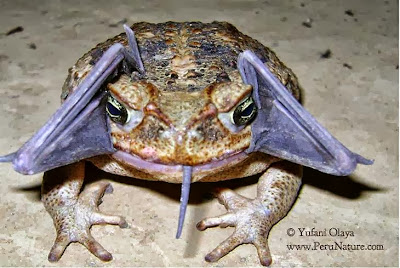Is it a new species? A mutant? A Photoshopped chimera? Nope; the subject of the picture above is weirder than that. Taken by a park ranger deep in a Peruvian rainforest, the shot shows a cane toad attempting to swallow a bat — whole.
Yufani Olaya told the Rainforest Expeditions blog that he witnessed the entire drama play out while on duty in Cerros de Amotape national park.
According to Olaya, this cane toad (Bufo marinus) was simply sitting on the ground with its mouth open, likely hoping to find an unwary insect to gobble, when the bat entered its vicinity — perhaps thinking the same thing.
Either mistakenly or with deadly intent, the toad reportedly lunged out and clamped its ample jaws down on the hapless mammal, or as much of it as it could cram in. The wings and tail, sticking out, lent a comic cast to the scene as Olaya snapped the picture.
"Toads are voracious and will eat pretty much anything that moves and can fit in their mouth," Adam Leaché, assistant professor of herpetology at the University of Washington, wrote in an email to NBC News. But, he added, "I've never seen something like this before."
This would be curtains for a beetle or millipede, but either the taste or the size of the bat seemed to disagree with the toad — and after a moment which likely proved uncomfortable for both the devourer and devouree, the toad spat out its would-be dinner.
"Cane toads don't have teeth, so the strategy is crush and swallow," wrote Charles Linkem, postdoctoral fellow at UW's biology department and a colleague of Leaché's, in an email to NBC News. "The bat was a little big for that. The toad may have tried to reposition its mouth to swallow and that was when the bat was able to escape."
Olaya thought the bat was finished for sure, but amazingly, the creature shook it off and flew away shortly thereafter.
Cane toads are not very picky eaters, which has allowed them to invade many habitats. While none have been observed eating a bat before, neither Leaché nor Linkem saw any reason why it should not be possible.
"It could be this population of toads have developed a strategy for feeding on low flying bats and that this is more common, but never observed before now," Linkem speculated. "It's hard to know without more information."
Leaché did caution, however, that there's also no hard evidence that the toad caught the bat in flight, as opposed to ambushing it on the ground, or getting at it by some other means. And the claws and bones of the bat might make digestion and excretion an issue for the toad.
Whatever the case, it makes for a great photo — even if it looks like neither the toad nor the bat was enjoying itself.

No comments:
Post a Comment